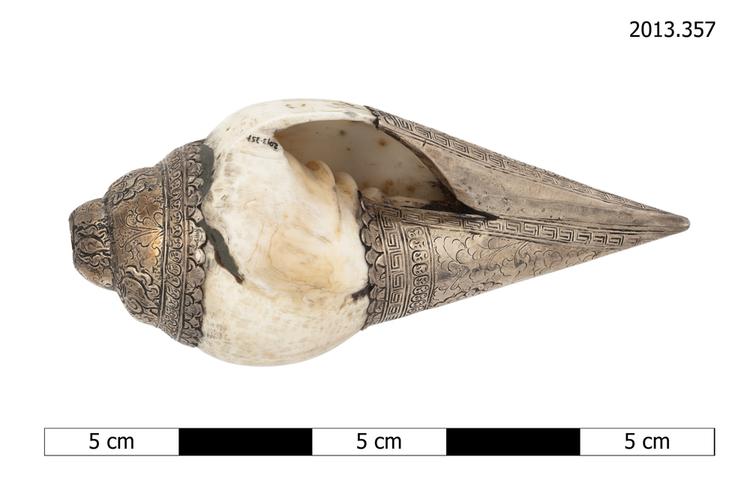Early brass
All instruments sounded using a lip-buzzing technique are categorised as ‘brass’, but not all are made of brass.
The earliest of these, the musical shell or conch, comes almost ready-made from the sea. It was used to communicate over long distances, and, like its brass successors, was associated with power and prestige. In some traditions, it also signified the breath of life. The sounding of the conch introduces our playlist.

423.111.2 End-blown conches with mouthpiece
Musical Instruments
Olympics and Salpinx
In ancient Greece, the salpinx, a long straight trumpet, was partly made of brass. The ancient Olympics always opened with a trumpet competition and the winner gained the privilege of introducing all the events. No music from the period survives, but a modern composition by the Greek musician and composer, Petros Tabouris, uses a reconstructed salpinx.
Parades and fanfare
The playlist briefly turns to the brass brand associated today with parades and marching down Main Street using a medley of familiar tunes by the prolific American composer and band-master, John Philip Sousa.
The fanfare, announcing high-ranking persons, was heavily associated with the commanding sound of brass instruments, and often relied on couplings with drums and percussion. Our first fanfare is for royalty, but the next, by American composer Aaron Copland, famously turns this idea on its head in his ‘Fanfare for The Common Man’. Contemporary composers took the cue creating fanfares to celebrate, for example, 150 years of the Railways in the UK.
Brassed Off
In mining and manufacturing regions across the UK, amateur brass bands became the backbone of workers’ social lives, signifying solidarity, conviviality and mutual support. Many of these bands attained extremely high levels of proficiency and, even after the factories and pits closed, remain a mark of pride in the communities’ work and heritage. This led to the tradition of brass band competitions, as shown in the hit film Brassed Off.
Two pieces played by the Desford Colliery Brass Band demonstrate the musical flexibility and virtuosity of one of these ensembles.
Brass and worship
Brass instruments interact with the acoustics of buildings in distinctive ways. In places of worship, the sound bounces off stone walls and vaulted ceilings creating impressive reverberations and echo effects. These were used most effectively in the 17th century by composers like Giovanni Gabriele at St Mark’s Cathedral in Venice. The building has multiple organ lofts where small ensembles of brass instruments were positioned to create awe-inspiring musical conversations between so-called ‘antiphonal’ or responsory instrumental choirs.
One of Gabriele’s contemporaries, Samuel Scheidt, used brass ensembles for an Intrada (Procession) and Battaglia (Battle), forms that have always been closely associated with the instruments. In the 18th century, brass took on virtuosic and solo roles such as in the well-known Trumpet Voluntary, The Prince of Denmark, by Jeremiah Clarke.
Alphorn, hunting horns and R&B
The alphorn, a traditional Swiss instrument which can be up to 4 meters long, is made from wood, and considered part of the brass family because of the lip-buzzing technique used to make it sound. Two short selections give a flavour of the alphorn on its own and in ensemble.
Outside churches, processions and battlefields, specific brass instruments were designed for use in recreational hunts (the hunting horn), and to announce the approaching mail coaches (the post horn). Listen out for examples of these and have a look for them in the Music Gallery.
Brass instruments remain among the most versatile, employed in all genres, from dance bands and jazz to hip-hop and R&B. Examples on the playlist feature many genres and members of the brass family, including trombones and the French horn.
The solo bugle
Whilst much brass music is fun and celebrates life, humans seem especially drawn to brass for sombre occasions. The closing pieces in the playlist demonstrate this with two funeral odes, finishing with The Last Post which, in the simplicity of the solo bugle, lends dignity to lives lost in war.
Hear the playlist below or every Tuesday in July at 3.30pm in the Music Gallery.


